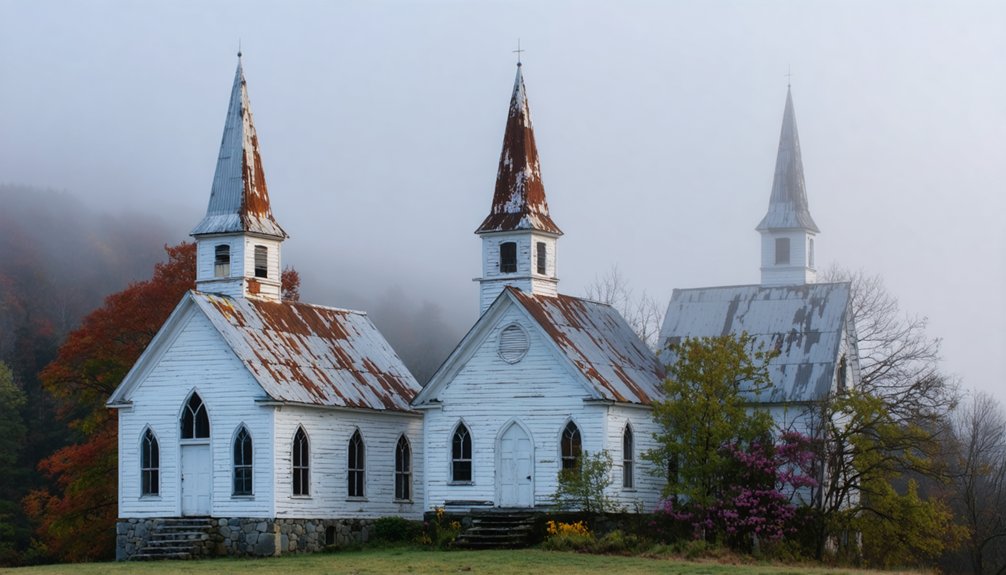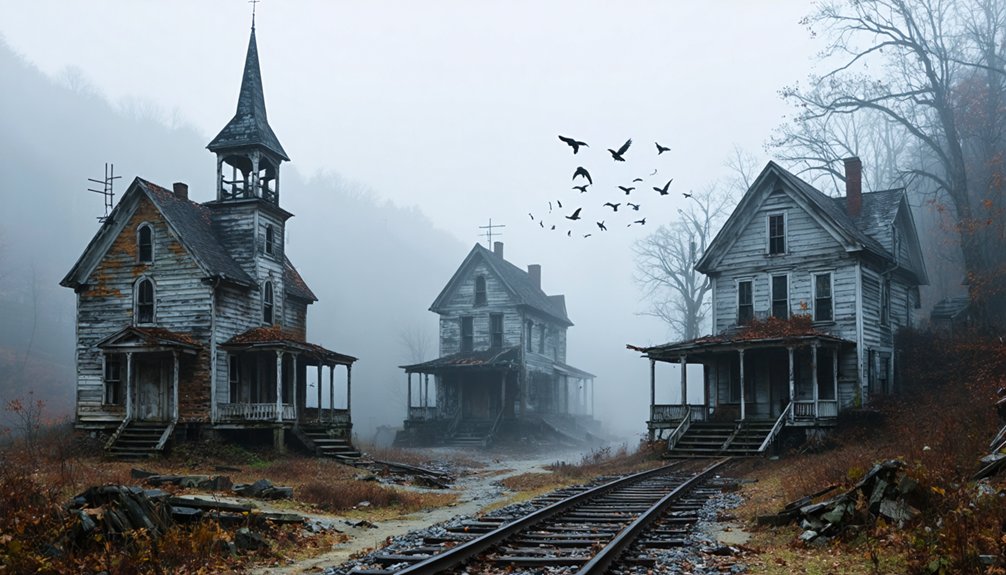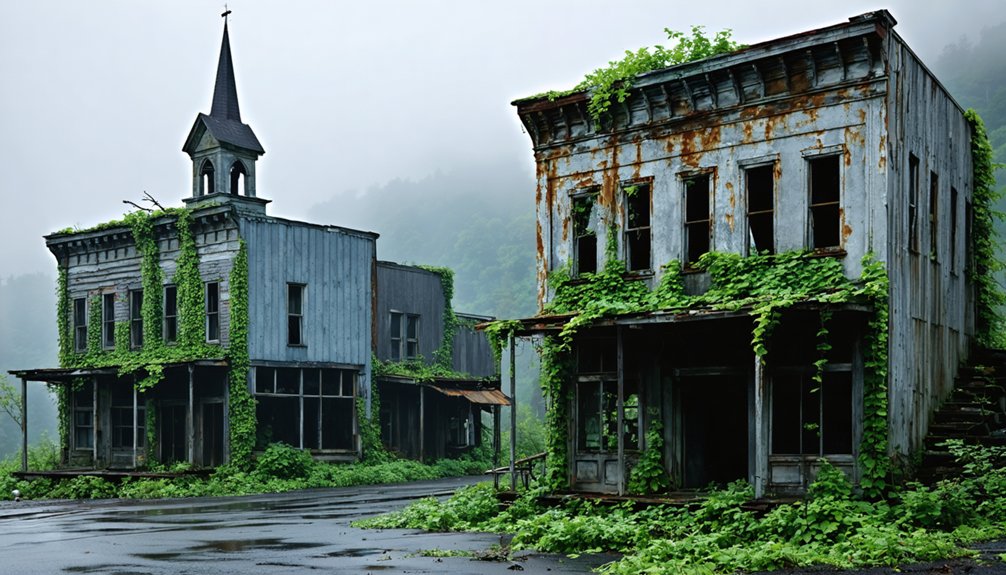You’ll find three remarkable ghost town churches in the Appalachian Mountains that stand as symbols of mountain faith. Jones Gap Baptist Church in North Carolina features striking Gothic Revival architecture with distinctive red wooden siding. Virginia’s Bald Rock Methodist Church, built in 1904, showcases local stonework and a modest steeple. The Missionary Baptist Church of Cades Cove in Tennessee’s Great Smoky Mountains represents enduring worship traditions. Each structure reveals fascinating chapters of Appalachian religious heritage.
Key Takeaways
- Jones Gap Baptist Church in North Carolina features Gothic Revival architecture and continues to attract visitors despite abandonment in 1998.
- Bald Rock Methodist Church in Virginia, built in 1904-1905, showcases early 20th-century architecture with a foundation of local creek stones.
- The Missionary Baptist Church of Cades Cove, built in 1915, is well-preserved within the Great Smoky Mountains National Park.
- These historic churches feature distinctive architectural elements including weathered stained glass, wooden spires, and Gothic styling.
- Each church served as both spiritual and community centers before abandonment, preserving Appalachian heritage and settlement history.
Jones Gap Baptist Church: A Gothic Revival Survivor in North Carolina
The Jones Gap Baptist Church stands as a poignant tribute to Appalachian religious heritage, nestled on a picturesque hillside near Hendersonville, North Carolina. Surrounded by whispering pines just 32 miles from Pisgah National Forest, this 1913 structure carries profound historical significance as a community pillar that survived a 1971 fire. The church attracts many urban explorers who document its gradual decay through photography.
You’ll marvel at its distinctive architectural details—Gothic Revival styling with red wooden siding, arched windows and doors, and an empty bell tower crowned by a wooden spire with broken cross. The rare Neo-Gothic brick construction distinguishes it from typical country churches, while weathered stained glass windows tell silent stories.
Though abandoned in 1998 when the congregation relocated across the street, preservation efforts continue despite ownership complications and structural instability that make visiting dangerous. The church sits at the crossroads junction of Hebron Road, Finley Cove Road, and Limberlost Drive, adding historical context to Henderson County’s natural landscape.
Bald Rock Methodist Church: Heritage Preserved in Virginia’s Mountains
Nestled in the undulating terrain of Grayson County, Virginia, Bald Rock Methodist Church stands as a tribute to Appalachian religious heritage at the junction of Routes 672 and 674 near Roberts Cove.
Constructed in 1904 and dedicated in 1905, this three-bay wood-frame structure exemplifies early 20th-century mountain church architecture with remarkable architectural integrity.
The church’s foundation of local flat, shell-type stones from Metal Fox Creek anchors its historical significance.
Until its closure in the 1980s, Bald Rock served as the community’s spiritual and social hub, hosting worship services, school lessons, and traditional gatherings.
Now listed in Virginia’s historic inventory, the church returned to the Roberts family in 1991.
Behind the modest steeple, a cemetery crowns the knoll, preserving names of early settlers—silent testimonies to Appalachian resilience, faith, and community.
The interior layout reflected historical social customs with separate seating areas for men and women, divided by a wall that prevented visual contact during services.
Missionary Baptist Church of Cades Cove: Tennessee’s Mountain Testament
Perched amid the verdant valleys of Tennessee’s Great Smoky Mountains, Missionary Baptist Church of Cades Cove represents a profound chapter in Appalachian religious history. Born from doctrinal division in 1841, this congregation weathered Civil War disruption and an unexplained 1880s dormancy before experiencing revival under Rev. Thomas Sexton in 1893. Vibrant daffodil displays bloom between the church and Tater Branch as a memorial to the Civilian Conservation Corps.
The church’s historical significance extends through its architecture—the 1915 structure you’ll see today features distinctive elements including a bell tower and bay window behind the pulpit. Unfinished wooden pews flank the center aisle, embodying the simple faith of these resilient pioneers. Behind the church lies a historic graveyard containing the remains of early settlers and community members.
Now preserved within Great Smoky Mountains National Park, this representation of Appalachian spiritual life stands as one of Cades Cove’s best-preserved historic churches, inviting you to witness the enduring legacy of mountain worship.
Frequently Asked Questions
Were Any Famous Preachers Associated With These Historic Appalachian Churches?
You’d think these remote pulpits remained anonymous, yet Shu Sterns and John McCampbell delivered historic sermons that echo still. Their influential ministries established enduring Baptist and Methodist foundations throughout Appalachia’s mountain communities.
What Religious Artifacts Remain Inside These Abandoned Mountain Churches?
You’ll find weathered Bibles, hand-carved pulpits, and communion sets remaining alongside brass candlesticks, religious symbols, and architectural features like limestone altars—all tributes to Appalachian spiritual resilience despite abandonment.
Do Paranormal Activities Occur in These Appalachian Ghost Town Churches?
You’ll encounter widespread reports of paranormal activity, from ghost sightings of former congregants to unexplained musical phenomena. Paranormal investigations consistently document temperature anomalies, EVP recordings, and apparitions near these sacred mountain sanctuaries.
Can These Historic Churches Be Rented for Weddings or Events?
Yes, you’ll find several historic Appalachian churches serve as wedding venues and event spaces, offering rustic charm while balancing preservation with modern amenities needed for your meaningful celebration.
How Did Prohibition and Moonshining Impact These Religious Mountain Communities?
Prohibition created profound tensions in your mountain faith communities, as moonshining history reveals both economic necessity and religious conflict. You’ll find this complex relationship transformed church dynamics and community impact throughout Appalachia.
References
- https://www.islands.com/1978893/old-jones-gap-church-abandoned-north-carolina-mountains-hauntingly-beautiful-historic-location/
- https://www.youtube.com/watch?v=9wg4TyNxEdY
- https://www.youtube.com/watch?v=54qnVKIYI00
- https://www.youtube.com/watch?v=4oHlJFXbrCk
- https://theforgottensouth.com/ghost-towns/
- https://www.youtube.com/watch?v=NFkORhmPfg0
- https://www.backpacker.com/videos-photos/the-best-ghost-town-hikes-in-the-u-s/
- https://www.youtube.com/watch?v=CtA93ACBHXs
- https://www.youtube.com/watch?v=OpHKb-8CuP0
- https://midlifehealthyliving.com/an-abandoned-church-in-north-carolinas-mountains-is-a-stunningly-sacred-historic-location/



